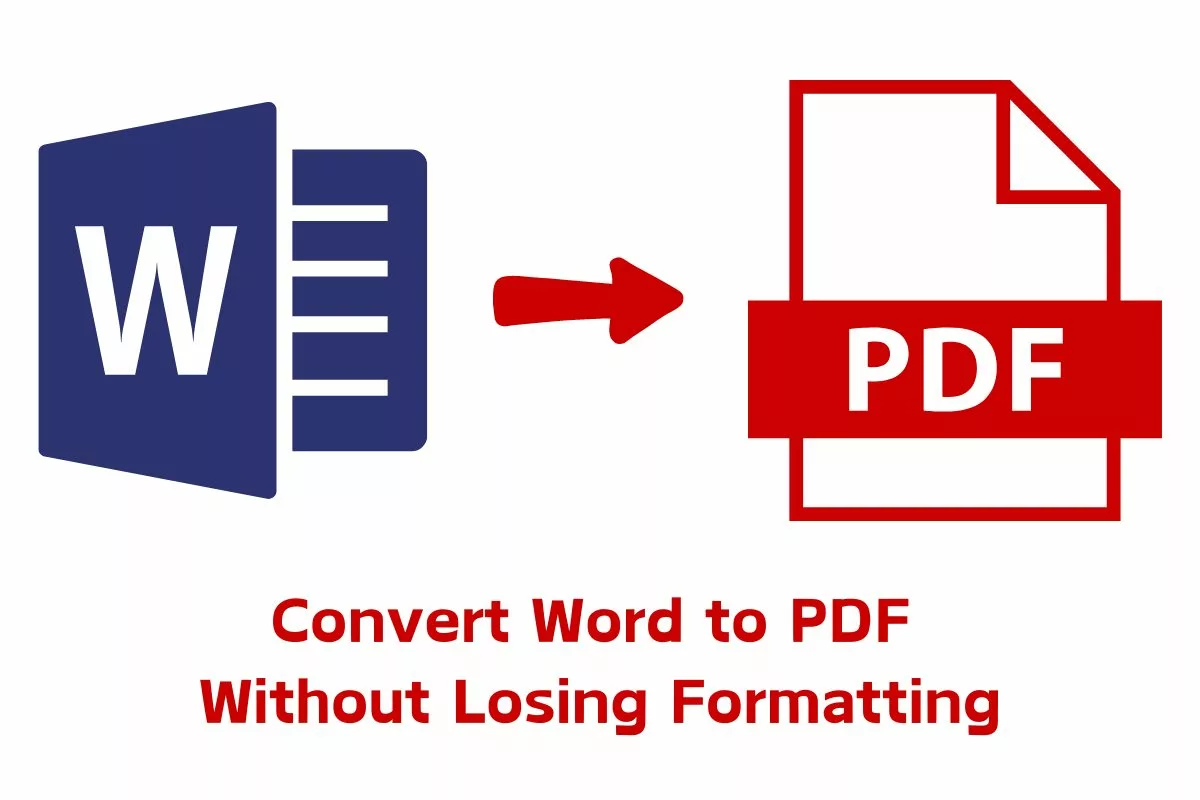How to Convert Word to PDF Without Losing Formatting?

It is a big challenge to convert Word files into PDFs using a Word-to-PDF converter and maintain the integrity and quality of the image. Once the Word file has been created and checked for syntax errors, it is time to download the file in its PDF format. During the Word to-PDF conversion process, the sanctity of the image must be maintained, and it should not suffer. Learn how to use a Word-to-PDF converter without losing formatting.
Importance of Maintaining Formatting During Word to PDF Conversion
Several tools can be utilized to maintain image quality, and the Adobe Acrobat Word to PDF converter online, for free, is one such tool. All the user has to do is upload the Word document and let the Adobe Word to PDF converter service do the job for you.
The Acrobat free online Word-to-PDF converter can also be used and vice versa to convert PDF files into Word files. The quality of the PDF files is also of the highest order since you are using Adobe tools.
In case the user does not have the PDF tool, they can adjust the image DPI setting in Word before saving it as a PDF file. The user must go to the advanced settings in Word and alter the DPI settings to a higher order. Save, and then download the PDF file.
Formatting any file, such as adding subheadings and highlighting keywords, makes the information more easy to understand and accessible. However, the formatting must be maintained, and converting the file into PDF ensures that the formatting doesn’t change. PDF files are cost-effective, occupy less space, and are more secure because they can be made password-protected.
Understanding Formatting in Word Documents
By dividing material into parts and giving them headers, emphasizing essential phrases or concepts using bold, italics, or lists, and generating a strong first impression, formatting also increases the reader’s accessibility to the content. This includes achieving a professional look and feel, as well as choosing an appropriate font for the document type.
The content is divided into small and manageable portions, enabling readers to better understand the content. Headers, bold, and italics separate the most important components from the rest of the content. There are many tools for formatting in Word, including font, size, bold, italic, underlining, strikethrough, subscript, and superscript formatting options, as well as font color and highlight color.
Common Challenges in Word to PDF Conversion
PDF is one of the best options to save a document, as it offers a secure, fast, and easy process. Most applications like Word and Excel contain “Save as PDF” options, making it a universal choice. However, there could be some problems with converting Word to PDF, and let us learn how to take care of them.
1. Italics, Bold, Underline, and Fonts are not followed
This is a common problem and occurs because the font style is embedded in the Word template and not instantly embedded in the PDF. This issue can be solved by using the export method to ensure that these fonts are embedded and formatting is preserved.
2. Links are removed when converted
This could be caused by the links lacking details, the long links being incomplete, or the prefix “https:// or http://” not being correctly included. The text containing the links is separated by line breaks. Another mistake occurs when the user clicks on the “print to PDF” method instead of saving it as a PDF.
The optimal course of action is to ensure that all the information is correctly filled in. Additionally, make sure to put a space before and after the text hyperlinked and avoid breaking the content.
3. Conversion Problems
The possible reason could be the content being saturated with too many graphics, media, or attached objects, which cannot be supported by the processor. A failed or disrupted internet connection can also lead to a corrupted file.
The solution is to reduce the vectors or graphics in the content. Simplifying and flattening graphics using the “Print to PDF” method will reduce the data. Additionally, compression will make the file size smaller, helping to address loading issues.
4. One file becomes multiple PDFs
If the saved PDF results in multiple cut-up files instead of one file, there could be a fault in the settings. This issue may be caused by too many page breaks or sections. It can be solved by changing the paper settings and using standard Letter paper size before printing the PDF. If this does not work, you can extract the text using PDF-to-text converters and then paste the text back into Word before saving it as a PDF.
5. Comments and markups are gone
By default, comments and markups are not shown in Word processors. The issue can be solved by going to the Review option, clicking on ‘Track Changes,’ and then selecting ‘All Markup’ from the drop-down list. This will enable all comments and markups to be displayed.
Choosing The Right Word to PDF Converter
The PDF or Portable Document Format has gained widespread popularity due to its security features, unified formatting, and compatibility across various platforms. However, choosing the right Word to PDF-converter can be challenging. To convert PDF files to editable Word, Excel, etc., a reliable PDF converter is essential, and some of the key requisites are as follows:
1. Accuracy:
The PDF converter must be accurate and able to extract every element, including fonts, texts, graphs, and images. It should replicate the original formatting and layout entirely.
2. Various Converting Format Options:
The PDF converter should support different converting formats such as PDF to Word, JPG, PNG, PDF/A, PPT, etc.
3. Fast Processing:
Opting for a Word-to-PDF converter with high efficiency ensures that the conversion is completed in the shortest time possible. However, online PDF converters may be affected by variables like server performance, computer configuration, and file size.
4. Security of Online PDF Converter:
Ensure that the online PDF converter includes features like automatic deletion of uploaded files once the job is completed. Also, verify that the service uses SSL encryption to protect all your data. Choose a service that doesn’t require sending files via email.
5. Batch Conversion Capability:
Some online PDF converters offer the option to convert files in batches or different formats, saving a significant amount of time.
Tips for Handling Specific Formatting Elements:
The process of converting Word documents into PDF format requires extra attention to specific formatting elements to ensure a smooth transition without any bugs.
Tables and Columns:
Tables and columns facilitate organized data presentation for readers. Ensure that the conversion tool meets this essential criteria, and check for errors such as table borders, cell alignment, and text within cells. Some minor adjustments may be necessary.
Headers and Footers:
Headers and footers are crucial as they contain essential information, including page numbers, titles, and dates. Confirm that all this information is transferred accurately during the Word to PDF-conversion.
Page Breaks and Section Breaks:
Page breaks and section breaks are vital components in any content. Therefore, ensure that these breaks are maintained during the conversion process from Word document to PDF.
Fonts and Styles:
Fonts and styles are sometimes not replicated when converting a Word document to PDF. Check and ensure that fonts are embedded correctly during the conversion process.
Bullet Points and Numbering:
Bullet points and numbering are essential for document structure. Ensure that the structure and style are accurately copied from the original Word document during the conversion.
Images and Graphics:
Images and graphics enhance visual appeal and aid in content understanding. Verify that the placement of images is correct when converting the Word document to PDF format.
Testing and Formatting Integrity:
After completing the conversion of the Word document into PDF format using a Word-to-PDF converter, it is time to check the formatting integrity in an orderly fashion.
1. Proofread the PDF:
Thoroughly review the entire document and scrutinize finer details such as headings, paragraphs, and other formatted elements.
2. Interactive Components:
Check all interactive components, including hyperlinks, forms, and bookmarks, to ensure that these elements function correctly in the PDF format. Verify if hyperlinks navigate to the correct web pages.
3. Print Simulation:
Take a printout to examine issues related to headers, margins, footers, and page layout in greater detail.
4. Compatibility Check:
Confirm whether the PDF is compatible with screen readers and adheres to accessibility standards.
5. Cross-Platform Compatibility:
Verify that the formatting remains consistent across various devices and operating systems.
Conclusion
PDF offers numerous advantages and stands as a preferred format in the business and commerce field. It is fast, maintaining the integrity of graphics and images during the conversion from Word to PDF. PDF files can be compressed, requiring less storage space. The PDF format provides a range of benefits for users.










